Dominant seventh sharp ninth chord
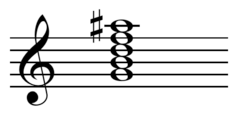
G B D F A♯ (A♯=B♭)
 |
|
| Problems playing this file? See media help. | |
| Component intervals from root | |
|---|---|
| sharp ninth | |
| flat seventh | |
| perfect fifth | |
| major third | |
| root | |
| Tuning | |
| 5-32 or 5-limit JI 160:200:240:288:375[lower-alpha 1] | |
| Forte no. / | |
|
5-32 / |
In music, the dominant 7♯9 chord[1] ("dominant seven sharp nine" or "dominant seven sharp ninth") is a chord built by combining a dominant seventh with an augmented second. This chord is used in many forms of contemporary popular music, including jazz, funk, R&B, hip hop, rock and pop. As a dominant chord in diatonic harmony, it most commonly functions as a turnaround chord, returning to the tonic. However, the 7#9 is also frequently used in some styles as a tonic without the resolution typical of a dominant chord.
Name
The chord is also sometimes colloquially known, among pop and rock guitarists, as the Hendrix chord or Purple Haze chord, nicknamed for guitarist Jimi Hendrix,[2][3] who showed a preference for the chord and did a great deal to popularize its use in mainstream rock music.[4] When used by the Beatles it has also been called the Gretty chord although this can refer to a distinct 6 string version.[5][6]
Spelling and notation

There are two main ways to spell the chord, depending on the musical style, kind of musical notation (score or chord symbols), and personal taste. One consists of a dominant seventh chord with an added minor third, placed one or more octaves over the major third;[7][8] the other consists of a dominant seventh chord with an added augmented ninth.[9] Only the second type of notation can be represented using the common chord symbol notation systems.
Sometimes, in publications which include both scores and chord symbols, the score is notated with a both natural and flattened third, while the chord symbol has the sharpened ninth.[7][8]
Other more uncommon notations and names include major/minor or 7 (add min 3).[10]
Kenn Stephenson says that in rock music the sharp ninth spelling is much more prevalent than the split third version.[11]
Nature of the chord
The 7♯9 is an altered chord, and it is one option when seeing the chord symbol 7alt. It is functionally a dominant chord, and thus "wants" to resolve to the tonic in diatonic harmony.

Stuart Isacoff has called the chord "funky" or "bluesy", because of the tension "generated between the major third and the augmented ninth";[1] while Doug Munro deems it as "jazzy"[12] rather than bluesy. Eric Starr says that "the sharp nine tends to be edgier, bluesier, and meaner sounding [than the flat nine]."[13] In jazz, 7♯9 chords, along with 7♭9 chords, are often employed as the dominant chord in a minor ii-V-I turnaround. For example, a ii V I in Cm could be played as: Dm7♭5 - G7♯9 - Cm7.
The 7♯9 represents a major divergence in the world of tertian chord theory. That simplistic constructionist definition of chords being stacks of major and minor thirds does not satisfy the 7♯9, as the interval between the minor seventh and augmented ninth is that of an augmented third. Similar pertains to the rarer M7♭9, where the interval between the major seventh and minor ninth is that of a diminished third. Rather than allow the inclusion of diminished and augmented thirds into the theory fully, a typical solution in jazz is to define chords as stacks of chordal degrees, where each degree has some range of selection from which to take its note or notes.[14] Thus, for example, the ninth is available in flat, natural, sharp, and flat-and-sharp "alt" styles.
History
Classical
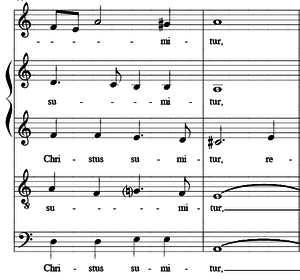
The English cadence is a distinctive contrapuntal pattern particular to the authentic or perfect cadence described as archaic[15] or old-fashioned[16] sounding. This pattern was primarily used by English composers of the High Renaissance and Restoration periods. The hallmark of this device is the dissonant augmented octave (compound augmented unison) produced by a false relation between the split seventh scale degree.
The English cadence is a type of full close featuring the blue seventh against the dominant chord[17] which in C would be B♭ and G-B♮-D.
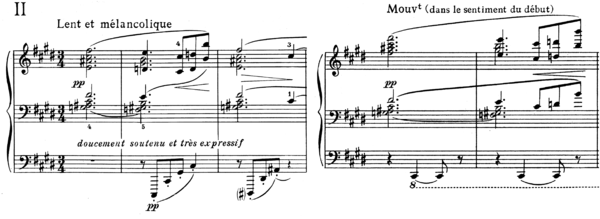
The dominant 7♯9 chord appears in impressionist classical music. An example can be heard in Claude Debussy's Feuilles Mortes, from his second book of Préludes (1913). There, the unresolved, dissonant ninth chords (at least a, "C♯7with a "split third" and "added minor ninth"[18]) help create, according to Richard Bass, an "utterly sad, desolate character," throughout the piece.[19]
This chord can also be found in serial music. For example, the Elektronische Musik vom Freitag aus Licht (1991–94) by Karlheinz Stockhausen, from an opera composed using formula technique, concludes on this chord.[20]
Jazz and blues

The dominant 7♯9 chord is normally found in blues contexts, because in a blues scale a minor third in the melody is usually played against a dominant seventh chord.[10]
The chord was used in popular music as far back as the bebop era of the 1940s, and, in instances, it appears with some regularity in blues and rhythm-and-blues of the 1950s and 1960s.
Rock/pop
Hendrix chord
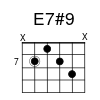
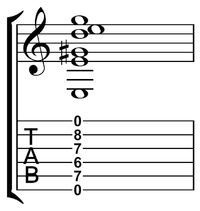
While this sonority has been previously used in jazz and related styles, one particular voicing of this chord is commonly nicknamed the "Hendrix Chord" among rock guitarists. This association is because it was a favorite of Jimi Hendrix, who did a great deal to popularize its use in mainstream rock music.[4]
The earliest recorded evidence of his use of the chord is on the Isley Brothers' "Testify, Parts 1 and 2" (1964), one of his few recordings before the start of his solo career in 1966. The most notable Hendrix song that features the 7♯9 chord is "Purple Haze", while it is also implied in "Foxy Lady",[22][23] both coming from his 1967 album Are You Experienced?. When performing "Voodoo Child (Slight Return)" live Hendrix later used not only E7♯9, the sharpened ninth chord on the tonic, but also D7♯9 and C7♯9 chords, the subtonic and submediant.[23]
This harmonic device is one of many factors that, according to Gleebeek and Spairo, contribute to "the dirty, raw, metallic, angular sounds of [...] Hendrix songs".[3] It is an example of how he would embellish chords "to add new colours to the music, often derived from his own roots in black music".[3] "In essence," John Perry writes, the Hendrix chord is "the whole of the blues scale condensed into a single chord."[23]
Other musicians
The chord was used by the Beatles in songs such as "The Word" and "Taxman".[24] McCartney called this a "great ham-fisted jazz chord" that was taught to them by Jim Gretty who worked at Hessey's music shop in Whitechapel, central Liverpool. George Harrison uses it as the penultimate chord of his solo on "Till There Was You".[5]
The chord (a D7#9) can also be heard in Pink Floyd's "Breathe",[25] and more prominently in "Shine On You Crazy Diamond", both before and after the final guitar solo, before the vocals come in.[26]
The chord is favored by Pixies lead guitarist Joey Santiago, with D7♯9, reminiscent of the opening to "A Hard Day's Night", opening and being called the "secret ingredient," to the song "Here Comes Your Man" and "brutally scraped" F7♯9 featured on the chorus to "Tame" against the three chord rhythm guitar part's D, C, and F chords.[27]
King's X are prominent users of the chord, notably in the chorus of Over My Head as well as featuring in Dogman.
Use as a primary or tonic chord in funk and disco of the 1970s includes Heatwave's "Boogie Nights".[11]
Notes
- ↑ A just major third (5/4), perfect fifth (3/2), minor seventh (9/5), and augmented second (75/64). Many other just tunings are possible, with higher limits allowing overtone tunings using smaller whole-number ratios, such as 10:12:14:19 or 20:24:28:37.
References
- 1 2 Isacoff, Stuart (1987). The 20-Minute Chords & Harmony Workout, p.111. ISBN 978-0-943748-41-2.
- ↑ Van Nuys, Calif: Alfred Publishing; New York: Penguin (2007). The Complete Idiot's Guide to Rock Guitar Songs, edited by Mike Sanders, Phil Kitchel, and Janette Lynn, p.58. ISBN 0-7390-4628-4.
- 1 2 3 Shapiro, Harry and Caesar Glebbeek (1995). Jimi Hendrix: Electric Gypsy, p.144. ISBN 0-312-13062-7.
- 1 2 "The 'Hendrix Chord'", Fender.com. Accessed 29 February 2012.
- 1 2 Pedler, Dominic (2003). The Songwriting Secrets of the Beatles, p.437. Omnibus Press. London. ISBN 978-1-4234-1345-5.
- ↑ "The Hendrix Chord", Aeoliancadenece.co.uk. Accessed 28 February 2012.
- 1 2 Pease & Pulling, pp. 33,76,77.
- 1 2 Waite, p. 53.
- ↑ Valerio & Bebop Jazz Piano, pp. 10,21.
- 1 2 3 Esterowitz, p. 68.
- 1 2 Stephenson, Ken (2002). What to Listen for in Rock: A Stylistic Analysis, p.84. ISBN 978-0-300-09239-4.
- ↑ Munro, Doug (2001). Jazz Guitar: Bebop and Beyond, p.58. ISBN 0-7579-8281-6.
- ↑ Eric Starr, Nelson Starr (2008). Everything Bass Guitar Book: From Lines and Licks to Chords and Charts - All You Need to Find Your Groove, unpaginated. ISBN 978-1-59869-483-3.
- ↑ Stanton, Kenneth. (1982) Jazz Theory: A Creative Approach, pg 61ff. New York: Taplinger.
- ↑ Carver, Anthony (1988). The Development of Sacred Polychoral Music to the Time of Schütz, p.136. ISBN 0-521-30398-2. If the clash cadence is already, "archaic, [and/or] mannered," in the music of Heinrich Schütz (1585-1672) it must surely be so now.
- ↑ Herissone, Rebecca (2001). Music Theory in Seventeenth-Century England, p.170. ISBN 0-19-816700-8.
- ↑ van der Merwe, Peter (2005). Roots of the Classical: The Popular Origins of Western Music, p.492. ISBN 0-19-816647-8.
- ↑ Bass, Richard (Autumn, 1994). "Models of Octatonic and Whole-Tone Interaction: George Crumb and His Predecessors", p.161, Journal of Music Theory, Vol. 38, No. 2., pp. 155-186. .
- ↑ Bruhn, Siglund (2007). Images and Ideas in Modern French Piano Music, p.172 and 174. ISBN 978-0-945193-95-1.
- ↑ Jerome Kohl, "Der Aspekt der Harmonik in Licht", in Internationales Stockhausen-Symposion 2000: Licht: Musikwissenschaftliches Institut der Universität zu Köln, 19. bis 22. Oktober 2000: Tagungsbericht, edited by Imke Misch and Christoph von Blumröder, 116–32. Signale aus Köln: Musik der Zeit 10 (Münster: Lit-Verlag, 2004): p.120. ISBN 3-8258-7944-5.
- ↑ Radio: "Shiver down the backbone - Jimi Hendrix comes to Radio 3", The Spectator, by Kate Chisholm, Wednesday, 21st November 2007
- ↑ Roby, Steven (2002). Black Gold: The Lost Archives of Jimi Hendrix, p.32. ISBN 0-8230-7854-X.
- 1 2 3 Perry, John (2004). Jimi Hendrix's Electric Ladyland, p.120-121. ISBN 0-8264-1571-7.
- ↑ Pedler (2003), p.440-441.
- ↑ Pink Floyd: The Dark Side of the Moon (1973 Pink Floyd Music Publishers Ltd., London, England, ISBN 0-7119-1028-6 [USA ISBN 0-8256-1078-8])
- ↑ Pink Floyd: Wish You Were Here (1975 Pink Floyd Music Publishers Ltd., London, England, ISBN 0-7119-1029-4 [USA ISBN 0-8256-1079-6])
- ↑ Sisario, Ben (2006). Doolittle, p.82 and 90. ISBN 0-8264-1774-4.
Further reading
- Hanford, John. "With the Power of Soul: Jimi Hendrix in Band of Gypsys" Ph.D. dissertation, University of Washington, 2003.
- van der Bliek, Rob. "The Hendrix Chord: Blues, Flexible Pitch Relationships, and Self-standing Harmony," Popular Music 26:2 (May 2007), pp 343–364.
- Ted Pose, Ken Pulling (2001). Michael Gold, ed. Modern Jazz Voicings (Paperback ed.). Berklee Press. ISBN 0-634-01443-9.
- Waite, Brian (1987). Modern Jazz Piano: A study in harmony and improvisation (Hardback ed.). Wise Publications. ISBN 0-7119-08-41-9.
- Valerio, John (2003). Bebop Jazz Piano. Hal Leonard. ISBN 0-634-03353-0.
- Valerio, John (2005). Post-bop Jazz Piano. Hal Leonard. ISBN 0-634-06123-2.
- Esterowitz, Michael (1987). How To Play From A Fake Book. Ekay Music. p. 168. ISBN 9780943748191.